Because for rational beings to see or re-cognize their experience in a new material form is an unbought grace of life. Experience translated into a new medium literally bestows a delightful playback of earlier awareness. The press repeats the excitement we have in using our wits, and by using our wits we can translate the outer world into the fabric of our own beings.
—Marshall McLuhan, Understanding Media (1964)
Is anyone surprised that McLuhan articulated the appeal of games writing over a decade before even Pong and Dungeons & Dragons were on the market?
I'm putting this last part out ahead of schedule because I'm ready to be done with it.
___________
We've come now to...something. I don't know.
My plan worked; I've lost my appetite for Magic: The Gathering. I don't want to dig up my old cards. My desire to visit the ol' hobby shop is all but extinguished. Try my hand at building an Orzhov deck? Why would I invest that kind of time and money when there's so much else I could be doing instead?
It should go without saying that I'm not keen on writing more about Magic. At this point, I don't think there's anything that could restore my enthusiasm for this blockheaded little project.




Wait a minute. A tower built by ur-golems? Where have I seen that before...?
The Tangle? The Razor Fields? The Mephidross and the Quicksilver Sea? I know those places!




Myr? And "-ok" tribes?! And worldbuilding through reiterative cycles?!
Hot dog! It's Mirrodin! We're back on Mirrodin!
Okay, okay. I lied. I'm not completely burned out, after all.
With Scars of Mirrodin (October 2010), the planeshopping era inaugurated after the Otaria Saga doubles back on itself, returning to the first stop in Magic's cruise across the multiverse: the Planet of the Artifacts. Unlike the visit to Dominaria in Time Spiral, this isn't a nostalgia trip.
Let's talk about what hasn't changed. Mirrodin is still a metallic terrarium orbited by five orbed mana "suns." The Mirrodin block emphasized artifacts, and so does the sequel: about one third of Scars of Mirrodin's 249 cards are artifacts. In lieu of the busted mechanics from the first Mirrodin block, Scars of Mirrodin introduces the somewhat underwhelming "metalcraft" ability, which makes things happen if you've got at least three artifacts on the board. It's not as exciting (or potentially game-breaking) as affinity, modular, or artifact lands, but artifacts still matter on Mirrodin.
Mirrodin's familiar denizens are still where we left them—which would probably come as a surprise to anyone who actually read the books. The novel The Fifth Dawn ended with the destruction of Memnarch's soul traps, flushing Mirrodin of all the living beings born of the soul-stuff of the original captives fished from other planes. As far as retcons go, this one is fairly gigantic—but then again, if people really cared about what happened in the novels, Wizards wouldn't have reduced its publishing output to one book per block.
At any rate: without the retcon, there wouldn't have been a Scars of Mirrodin at all. So let's just go with the flow when the flavor text suggests that it was only the "Mirran elders" who got sent back to their homeworlds when the soul traps were broken.

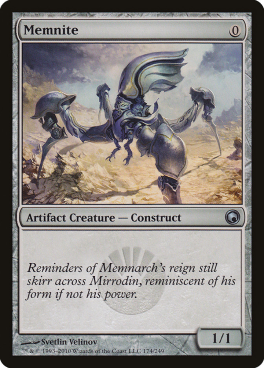


Now: what's new on Mirrodin?
First of all, notice how different it looks now. The original Mirrodin block's artwork was developed under the supervision of Jeremy Cranford, possibly Magic's most maligned art director, who took the reins during the period when Magic's visual blandness was at its zenith, and he wasn't interested in making any improvements until after Rebecca Guay's fans got nasty. In Scars of Mirrodin, Magic illustrators are clearly asked to conform to a house style, but at least that house style applies itself toward complementing Magic's most alien plane with a suitably otherworldly aesthetic.
We've already mentioned metalcraft, the first of Scars' three new mechanics. The second is "proliferate," which is a little wonky: when the rules text tells you to "proliferate," you can choose to put an additional counter of any type that's already on a creature or player on that creature or player. The original Mirrodin had a bunch of artifacts whose activation required charge counters, and so does Scars—so that makes sense. But what about players with counters? The only counter I can think of that applies to players are poison counters.
Remember poison counters? Way back in the day—we're talking Legends, Alliances, and Mirage, here—there were creatures that gave opponents a poison counter if they weren't blocked, and ten poison counters meant game over. It never really took off. Unless I miscount, there were only five cards that gave out poison counters as of Future Sight. And I hardly see how poison connects with the Planet of the Artifacts conceit.
Hrm. Maybe it would be better to just lay out a few cards and see what they have to tell us about what's happening on Mirrodin these days:


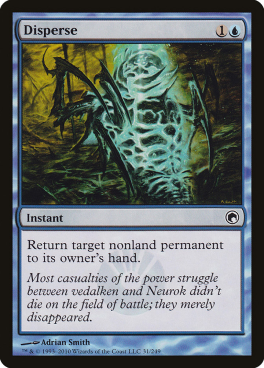








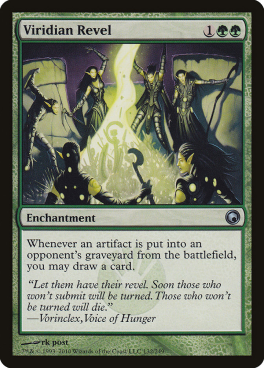
Well, that certainly waxed ominous.
Okay, so: after Memnarch and older generations disappeared without a trace, Mirrodin's tribes have fallen into disarray and factional war. Meanwhile, it seems a new malefactor has been gathering strength in places unseen, and is now beginning to make its opening move.
What is this mysterious new threat, you ask?
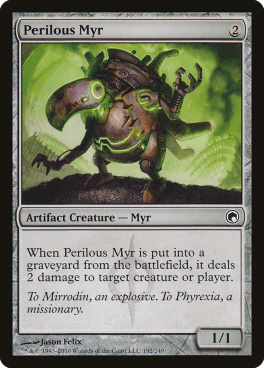



Ah, okay. It's Phyrexia again. Anyway: Vector Asp (above) gives us an example of "infect," the third mechanic introduced in...
Wait, what? Phyrexia? Wasn't it utterly and permanently destroyed at the end of the Invasion block?
Remember that unaccountable spot of oil Memnarch noticed just before he started acting funny? Of course you don't; you didn't read the books. In the first chapter of the first Mirrodin novel, Memnarch casually wipes away a mysterious oil stain on a wall in the citadel Karn left him in, and immediately begins experiencing some unusual thoughts. The narration tells us the oil was "created as a weapon," and had "lain dormant" after "the war for which it was created had long since passed." Before it carried out its next objective, it must "divide and grow."
By the end of the third Mirrodin novel, it seemed as though the second and third authors of the books made the choice to leave that plot thread dangling. From what I've skimmed, the oil doesn't come up again.
I'm not sure whether it's good or bad storytelling to leave a plot device in abeyance for seven years before reminding everyone that it's actually terribly important—but Magic storytelling, for better or worse, operates on a much broader time scale as it hops from world to world, and from scenario to scenario. In any event, the end is loose no more. The oil was indeed a remnant of Phyrexia which Karn unknowingly brought to the metal world he created. The oil, possibly leaking in sporadic, unnoticed drops from Memnarch's body, created the mycosynth—that mysterious fungoid organism whose spore converted metal into organic matter, and vice versa.
The oil's presence in Memnarch's body gradually drove him insane, but it didn't commandeer his will to the point where he ever gave up on trying to rid Mirrodin's core of the mycosynth. Now that he's gone, the mycosynth has grown unchecked in the planet's depths for decades, producing more oil as it spreads, and ultimately giving birth to a new breed of Phyrexian. In Scars of Mirrodin, we witness the first steps of their incursion onto the Mirran surface.
Great—so I guess we're rehashing the old "black-aligned Phyrexia faction versus the world," with every other color (and maybe a subset of black) representing the native Mirrans unified against a common threat. Just like in the Invasion block, the Phyrexians' restriction to black cards will result in them coming across as a tiny splinter group instead of a thronging existential menace.


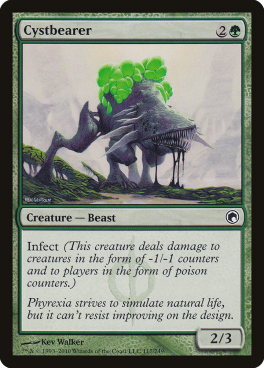
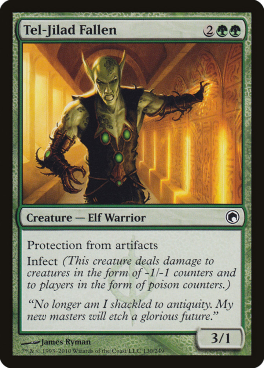
...Huh. Nonblack Phyrexians. Okay, that's new.
Under Yawgmoth's management, Phyrexia just killed the fuck out of everyone and repurposed their corpses. The Mirrodin strain is more insidious: it infects, perverts, and transforms. The glistening oil doesn't just make people sick; it turns them into Phyrexians. (I had to correct myself just now; I typed "black oil" instead of "glistening oil." It's a safe bet that The X-Files lingered in the memory of Magic's creative team circa 2003.)
The cards don't spell out the reason for the change in Phyrexia's modus operandi, but I don't think they need to. The apophenic fan-brain can work out an explanation on its own. This "new Phyrexia" (if you will) is a strain formed from a biological weapon developed for use on Dominaria. Notice the dark ichor depicted in the black cards in Time Spiral; that's a remnant of the Phyrexian invasion, and probably the same stuff that Karn unwittingly carried to Mirrodin. If it didn't take root in Dominaria, let's say it's because the planet's natural life force (or, hell, its microflora) resisted the oil the way an animal's immune system fights off a pathogen. But an artificial plane like Mirrodin doesn't have the same defenses, and adventitiously proved the perfect environment for a parasitic organism engineered on another world of metal. Moreover, its living inhabitants are all flesh/metal hybrids—already halfway Phyrexian.
Long story short: Mirrodin and Phyrexia were a match made in hell.
You ask: if Mirrans and Phyrexians can't be distinguished on the basis of color identity, how do we know which is which? The answer: watermarks! Except for basic lands and planeswalkers, every card in the Scars block has a watermark that indicates whether it's Mirran or Phyrexian.

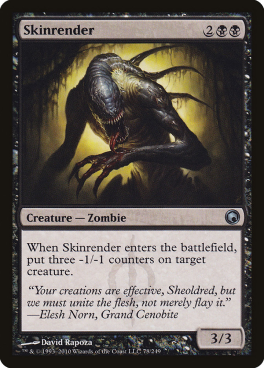
They're a bit harder to see on digital scans than on the actual cardboard, but the card on the left has Mirrodin's "sunburst" emblem inside the text box, while the one on the right bears the Phyrexian symbol (first seen on Gix's forehead in Urza's Saga, unless I'm mistaken).
Again, long story short: Mirran cards care about artifacts; Phyrexian cards care about putting -1/-1 counters on creatures, sticking players with poison counters, exacerbating the infection with proliferate, and making everyone unhappy. (For the effect to have been truly perfect, affinity and modular needed to come back—but that would have caused ripples of consternation among players who remembered Combo Winter Part Deux.)





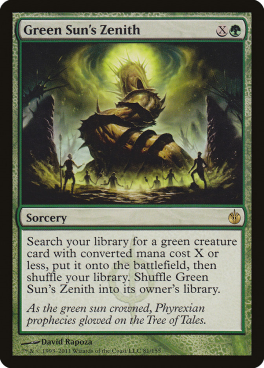


Mirrodin Besieged is spooky. It would be one thing if it were just a war story, but the infection trope (reinforced by the diagnostic watermarks) gives it a stranger, darker dimension. The glistening oil is corrupting Mirrans and warping the landscape, and the sinister impression is of a world whose very reality is changing. Green Sun's Zenith (above) is particularly haunting in this respect. It's excellent, excellent worldbuilding, and it's the sort of thing that wouldn't have quite the same effect in any other narrative medium I can think of.



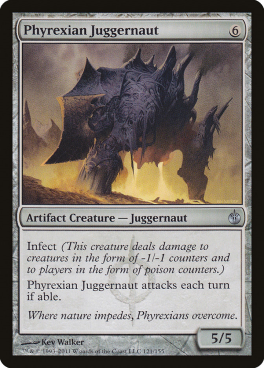
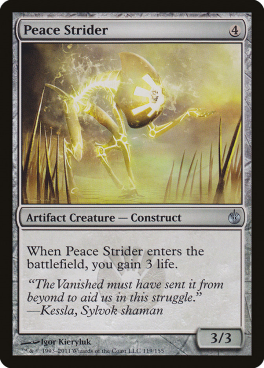



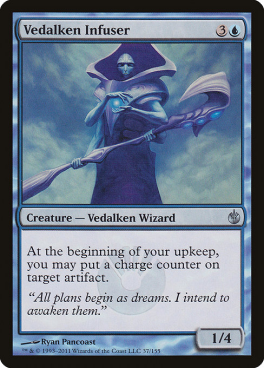


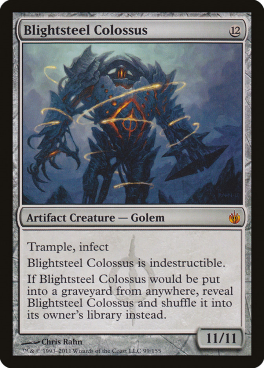














Wizards kept name of the Scars block's third set a secret for as long as it could, since releasing it was guaranteed to spoil the outcome of the war. Two possible names were teased for the finale: "Mirrodin Pure" and "New Phyrexia."




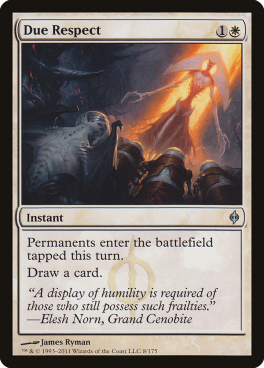





...But, jeez, it's not looking good.
















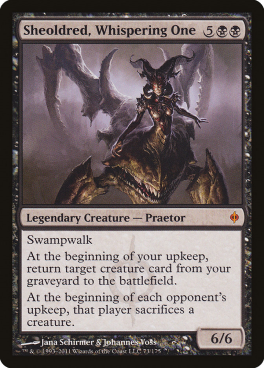








Oh. And there's planeswalkers.




I really can't think of enough good things to say about the lore of the Scars block. It's damn near perfect—and I know I keep harping on this, but its story couldn't have told in the context of any other fictional mythos, and its world that couldn't have been built in any other format. It needed the watermarks, the game mechanics, the three-set timescale, and the narrative mosaic of collectible cards just as much as it needed the heft and conceptual framework of Mirrodin, Phyrexia, and the Magic color philosophy.


So how many Phyrexians are running amok on Mirrodin's surface? Hunh. I guess I'll have to do some counting.
Black is already the worst off; two thirds of Scars' black cards are Phyrexian. No surprise there. Green comes in second in the race to the bottom: of twenty-seven green cards, six are Phyrexian. That makes sense, actually: up until the Scars blocks, the cards that handed out poison counters were primarily green.
Of twenty-six blue cards, four are Phyrexian. White and red are untouched. Of the artifacts, less than fifteen percent are Phyrexian.
So it looks like Mirrodin's still in altogether decent shape...but this is only the first third of the trilogy.


It's unclear how much time passes between Scars of Mirrodin and Mirrodin Besieged (February 2011), but the set's title tells you all you need to know about how the situation has changed. The Mirran natives have put aside their squabbles and turf wars and formed a united front against the Phyrexian invaders pouring out of the metal world's subterranea.






Yes, yes—that's a white Phyrexian card. Back in the day, such a thing would have been unimaginable. But that's an effect of the substratum on which the new Phyrexians have taken root. Yawgmoth's Phyrexia had only black mana, while Mirrodin has five mana orbs irradiating it with the magical spectrum. They're having a peculiar influence on the Phyrexians' development.
Let's see how things stand. In Mirrodin Besieged, each color gets nineteen cards. Let's count the number of Phyrexian cards in each one:
Black: Seventeen Phyrexian cards.
Green: Thirteen Phyrexian cards.
Blue: Nine Phyrexian cards.
White: Six Phyrexian cards.
Red: Three Phyrexian cards.
Surprised that white isn't the most resilient against the Phyrexian contagion? There's a reason for that—we'll get into it later.
Also: of forty-six artifact cards, twenty-two are Phyrexian. Just a smidge less than half.
Sure, we already saw this in Lorywn/Shadowmoor—except this time Shadowmoor is trying to replace Lorwyn by killing and devouring it, and Lorywn is having none of it.










Mirrored pairs like these put in a lot of work towards conveying the drama of the conflict, and it's most effective when they're not simply the same cards with different colors, watermarks, and inverted effects, but when their in-game functions are distinctly Mirran and Phyrexian. The Veldalken Infuser/Vedalken Anatomist duo is the best of these, I think: they're a little bit like snapshots taken before and after a person's exposure to QAnon, anime, or any other virulent social contagion.
Some of the pairs reach into Mirrodin's history:












(1) Yes, yes, those are just variants of Phyrexian Rager, and the first has nothing to do with Mirrodin. Its just interesting to see what a tremendous difference there is between typical Magic illustrations developed ten years apart.
(2) Yes, that's Glissa, protagonist of the Mirrodin novels and the hero who deposed Memnarch. The Phyrexians got to her.
It's also worth mentioning that the Fightin' Mirrans get a new ability in the set: battle cry. It's boring, but useful.
Meanwhile, the Phyrexians get a new artifact subtype: living weapons, equipment that comes into play attached to a self-generated "germ" creature. It's not so boring, and it certainly exemplifies the character of Phyrexia more than battle cry represents what Mirrodin is about—but battle cry is probably more practical.




So which will it be? Will the nightmarish scions of Yawgmoth prevail? Or will the heroes of Mirrodin beat back the Phyrexian abominations and restore harmony to their weird and wonderful world??






Okay. New Phyrexia (May 2011) it is, then.
It's not even worth counting the number of Mirran cards left to each color. White and red are tied for the most: four Mirran to twenty-one Phyrexian watermarks.
It probably had to end this way: Mirrodin Pure would have been awfully anticlimactic. Still, it's hard not to be impressed by Wizards' audacity in bringing back one of its most beloved properties (if sales numbers are anything to go by), just to make it the subject of a snuff film. You love to see it. Or maybe you hate to see it. I'm not entirely sure. It's a magnificently enacted piece of commercial art, but it's hard not to be disturbed by the depths of the creative team's commitment to its study of the vivisection of a world and its people.
The Mirrans haven't been completely exterminated, though. Pockets of survivors and heroes remain determined to fight until the end, and they've discovered a mysterious Sylvok girl who can pass on her strange immunity to the glistening oil...










Notice the mana symbol in the casting cost of Gitaxian Probe—that's Phyrexian mana, New Phyrexia's debut mechanic. It contributes to the lore by underscoring the extent to which Phyrexia has subsumed the very essence of Mirrodin, changing even the nature of its mana. It's also broken as hell, and is often spoken of with even more disdain and regret as the Mirrodin mechanics that enabled Ravager Affinity.
The acculturation (if we can call it that) of Phyrexia to a world with a full mana spectrum was something that the designers put a great deal of thought into, and the result is some of the most impressive worldbuilding Magic has ever executed. The black cards must have been the easiest to figure out: it's just the familiar ethos of old-school Phyrexia in a different setting. Oppress, dominate, slaughter, reanimate, and so on. But determining how Phyrexia would digest and be changed by white and green mana—typically Magic's goodguy colors—must have been a blast to think through. The cards still had to abide by the norms of the Magic "color pie," meaning that white and green cards needed to behave like white and green cards elsewhere, but with a little added dash of ghoulishness and sadism. Aesthetically, they had to represent those colors' respective philosophies taken to their cruelest, ghastliest extremes.
In short: white-aligned Phyrexians are like the government of Oceana in the novel 1984 if it were also the Catholic Church, and the image of Big Brother was an icon of Christ. Green-aligned Phyrexians make the Nazis' commitment to social Darwinism seem embarrassingly halfhearted.






Notice the second sentence in the rules text of Glissa's Scorn, and compare it with Victorious Destruction (both above). There are a few other (Phyrexian) cards like this: they do something useful, and have the ancillary effect of making your opponent lose a life point. That's just so fitting. It's perfect. Not only does Glissa break your Mindslaver or Sol Ring, she also dings you for one life—just to be mean.
Hmm. There's that name again in Mycosynth Fiend: Vorinclex. He's been chiming in ever since Scars of Mirrodin. So have a few other voices. If you were the sort of person who was paying very close attention when the block's eponymous first set was making the rounds, you would have noticed that there were five different Phyrexian voices in the flavor text: Vorinclex, Elesh Norn, Jin-Gitaxias, Sheoldred, and Urabrask. The Phyrexian peanut gallery expanded during Mirrodin Besieged, but the original five speakers continued their chatter.
Ravnica teased the unseen guilds. Zendikar teased the Eldrazi. Scars teases the praetors.


In New Phyrexia, we finally meet them: the bosses of New Phyrexia's five factions, the purest embodiments of the dialectic between Phyrexian depravity and colored mana. I have to hold them up as an example of perfection. On the whole, everything about them—from concept, to design, to execution—is flawless. They're one of the best things that Magic ever did.





If you've never played Magic (you're still reading this?) and aren't fluent in the jargon of its rules text, all you need to know about the praetors is summed up in the description of the Kill-o-Zap gun in the Hitchhiker's Guide to the Galaxy books:
The designer of the gun had clearly not been instructed to beat about the bush. "Make it evil," he'd been told. "Make it totally clear that this gun has a right end and a wrong end. Make it totally clear to anyone standing at the wrong end that things are going badly for them. If that means sticking all sort of spikes and prongs and blackened bits all over it then so be it. This is not a gun for hanging over the fireplace or sticking in the umbrella stand, it is a gun for going out and making people miserable with."
True, you could say this about the Eldrazi titans or even some of the nastier planeswalker cards—but none of them have the panache the praetors bring to the table. What they do is make your opponent feel violated. If you can get Jin-Gitaxias in play, you end every turn with seven cards in hand, while your opponent ends their every turn with zilch. Sheoldred gives you back one of your creatures at the beginning of your turns, and forces your opponent to give the Old Yeller treatment to one of their creatures when their turns begin. The praetors' extra abilities—Elesh Norn's vigilance, Vorinclex's trample, etc.—are just gratuitous and cruel. Superlatively on-brand for Phyrexia.
What elevates the praetors above the titans, in my humble opinion, is that each of them has such a palpable personality. The Eldrazi's whole schtick consisted in being inscrutable, uncommunicative, and utterly one-track in their behavior. Each praetor, on the other hand, represents a method and an ideal. Along with the rest of the Scars block, the praetors and their slanted interpretations of a core ethos bring Phyrexia more vividly and hideously to life than any of the sets that took place when Yawgmoth was in charge.
The prevailing opinion among players seems to be that Urabrask (the red one) is the least useful of the praetors. I can't decide whether this is a serendipitously apt coincidence or the designers' intent.
Remember how red was the color most resistant to subversion in Mirrodin Besieged? There's actually something about red mana that makes it less compatible with the Phyrexian ethic than the other colors. You can read the official take on it here, but the gist is that red's "chaotic neutral" mentality puts its faction at odds with the traditional Phyrexian values of procrustean hierarchy and the absolute subordination of the individual to the whole. Not that Urabrask and his minions in the furnace layer aren't savage, volatile brutes totally committed to their idea of the Phyrexian project, but Urabrask is also willing to turn a blind eye to Mirran refugees in his domain as long as they don't give him any reason to have them all killed. This is as close to "good" as Phyrexia gets.


Old-school monoblack Phyrexia operated in absolute lockstep. Under the influence of the complete mana spectrum, New Phyrexia is fragmented. Now that the war has been won and Mirrodin is theirs, the praetors and their respective tribes have very different ideas about what ought to be done with their new planet. As a matter of fact, the praetors don't like each other very much, and the acrimony falls along lines typical of Magic's enemy colors. The implication is that if the surviving Mirrans have any hope of taking back their world, they'll have to exploit the rifts opening up among their conquerors—the same way the Phyrexians staged their own assault when the Mirrans were riven by infighting.




I think it's safe to say that the planeswalkers are shown having more to do in Scars than they did in Alara or Zendikar, even if you aren't reading the books. Koth of the Hammer is a native Mirran with a stake in the conflict. Elspeth Tiral returns from her debut in Alara, and Venser, introduced as a legendary creature in Time Spiral, appears for the first (and only) time as a planeswalker. The battle is personal for each of them: Elspeth was raised on a world that was apparently dominated by leftover Phyrexians from Yawgmoth's time, and Venser is there to help his buddy Karn—who's desparked and imprisoned in the Mirran core, reeling with delirium while the glistening oil eats away at him and his Phyrexians wardens attempt to coerce him into inheriting Yawgmoth's title and role as Father of Machines. (He is responsible for their birth, after all.) Tezzeret from the Alara block and the Agents of Artiface novel is on the plane under orders from his boss Nicol Bolas. You can read all about it in a pair of webcomics and the Quest for Karn novel, if you want.
I'm not sure I recommend it, since none of them are as exciting or well-executed as the lore that's already in the cards. The comic about Tezzeret's meeting with Jin-Gitaxias is decent, but Quest for Karn appears to have earned a particularly poor reputation.
The grand scheme of planeswalker-centric rebranding still proceeds as it did before. Slow and steady. The 'walkers occasionally show up in the cards, and are quoted not infrequently in the flavor text, but they're definitely not the main attraction.




(I dig how the triumphant presentation of Karn Liberated is belied by the hopelessness of the overall situation. After all, as soon as the scion of Urza is freed and resparked, he promptly gets the hell out of Mirrodin New Phyrexia because he knows what's good for him. His escaping to fight another day is the only unambiguous point of light in the whole bleak affair.)
Even though I'm nostalgic for the purely experimental, by-the-seat-of-the-pants approach to worldbuilding Magic's early creative designers utilized as they explored the possibilities of the new medium, New Phyrexia is a triumph of tested methods and a concresced mythos. The fact that Phyrexia began as an ambiguous, sort of sinister thing with only a gate and some fanciful Amy Weber gremlins to its name, and additively grew into one of the most unforgettable and masterfully realized antagonists in any corner of pop culture, is truly astonishing. The experience is almost worth the personal cost of inviting worms into your brain.


Hmm. I collected a bunch of card scans from the Innistrad block, intending to make it the final chapter of this series. Up until now, I've been revising passages and filling out skeletal outlines composed during the winter, but hadn't gotten around to writing a single word about Innistrad. Even though it might be fun to review how a gothic horror set could have followed a macabre Phyrexian gorefest and managed not to come across as tonally repetitive, or the block's reversal of what had become an ingrained narrative arc by restoring harmony to its world in the third act...I think I'm good. I'm done with this for now.
At some point, I'm want to wrap this up with a quick overview of how things have progressed in the decade since New Phyrexia, but for the time being I really, really need to think about something else.


Well...all I can say is that it seems Magic aged better then Yu Gi Oh...sadly that game's devolved into utter convoluted nonsense...and I say that as a fan of the game.
ReplyDeleteWhile I'd love to read more of these I do think Scars block is a good note to end on since it does such a good job of looking back at Magic history.
ReplyDeleteAlso, I have to say that Phyrexian Unlife might be my favorite Magic card art ever.
T'was a fun read; I don't know if I should have read this as I never played MtG and I have enough brain worms to cherish and take care of.
ReplyDeleteYou should write a non fiction book that adapts your other (more gloomy) work in this blog about mass media, I think it would cause some ruckus, even tough it might happen after your death.
Tangentially related, should I check Hitchhiker's Guide to the Galaxy? Sounds fun, but not sure if I should worry about brain worms.